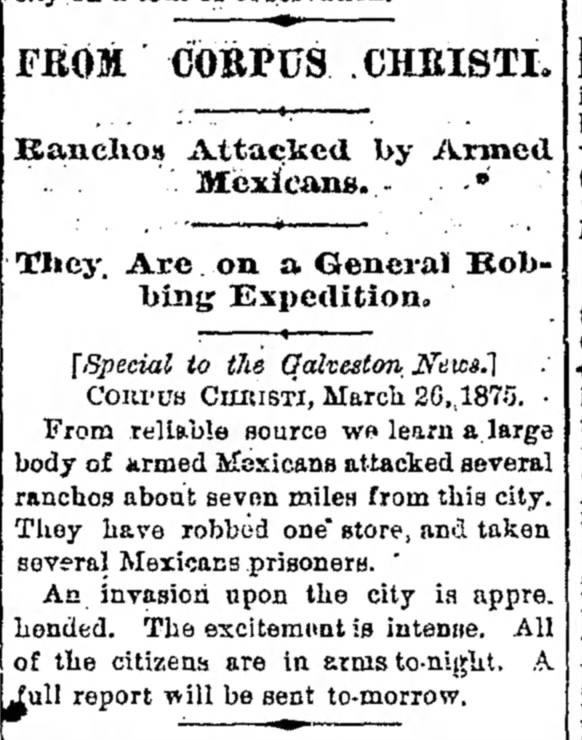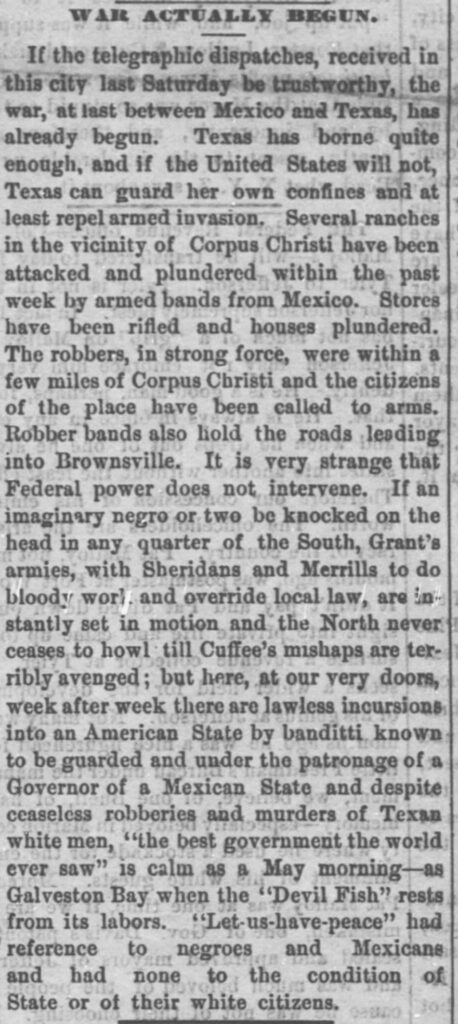#OTD in 1875 the Nuecestown Raid occurred. In the 1870s and 1880s across the Southwest, a number of raids by Mexican outlaws into the US, as well as Anglo raids into Mexico, took place. The raid on Nuecestown provoked lynching and large-scale massacres of Mexican people.

The raid began when approx. 15-30 outlaws swept Nueces Strip and began robbing farms and shops on the outskirts of Corpus Christi. They also took a number of hostages, all of whom were subsequently released. Having plundered the area, the raiders departed at nightfall.


The raid left 3-5 people dead. Local people and law enforcement responded by forming large posses to pursue the raiders. One militia group of 10 caught up with the raiders but in a pitched battle were forced to retreat. Most of the raiders disappeared into Mexico. White people in the region organized themselves into vigilance committees, many called “minute companies,” and killed dozens of Mexican-origin people in retaliation for the Nuecestown Raid. Anglos drove Mexicans from their properties and burned their homes.

We know relatively little about these vigilante groups or their victims. The state government sent in the Texas Rangers to halt the violence. While they did stop the white vigilantes, the Rangers also picked up where they left off.
[reference: Texas Frontier Troubles, Report No. 343, House of Representatives. U.S. Government Printing Office, 1876.]
Rangers executed a number of ethnic Mexicans. In another instance they ambushed a “party of raiders,” killed thirteen, and then took their bodies to Brownsville and laid them out on the courthouse green as a public display of Ranger strength. https://historymatters.gmu.edu/d/6534/
According to historian Jerry Thompson, since the Nuecestown raiders had stolen saddles the Rangers commanded that any Mexican-origin person seen riding a horse with a new saddle was to be gunned down or hanged without question.
“The Nuecestown Raid was devastating for the Mexican population of the Nueces Strip,” according to historian Miguel Ángel González-Quiroga. https://www.amazon.com/Grande-Frontier-1830-1880-Directions-History/dp/0806164980
The exact number in retaliation remains a mystery. J. Frank Dobie speculated that is more than died at the battle of San Jacinto. The raid’s aftermath is a sad example that lynching and massacres at the hands of law enforcement and vigilantes happened long before the 1910s.

This thread is a part of the #OTD in Ranger history campaign that @Refusing2Forget is running this year. Follow this twitter handle or https://refusingtoforget.org/ranger-bicentennial-project/, and visit our website https://refusingtoforget.org/ to learn more. /24
The key source for this thread is @HistoryBrian’s Borders of Violence and Justice: Mexicans, Mexican Americans, and Law Enforcement in the Southwest, 1835-1935
and Miguel Ángel Gonzalez de Quirogae War and Peace on the Rio Grande Frontier, 1830–1880
Refusing to Forget members are @ccarmonawriter @carmona2208 @acerift @soniahistoria @BenjaminHJohns1 @LeahLochoa @MonicaMnzMtz and @Alacranita, another co-founder is @GonzalesT956.
@emmpask @sdcroll @HistoryBrian @LorienTinuviel are other scholars working on this project.

